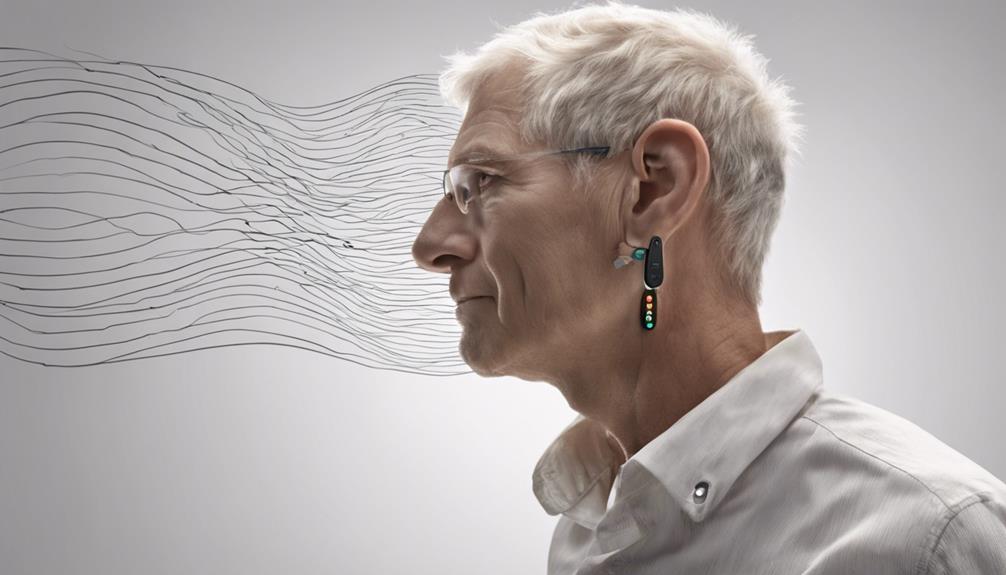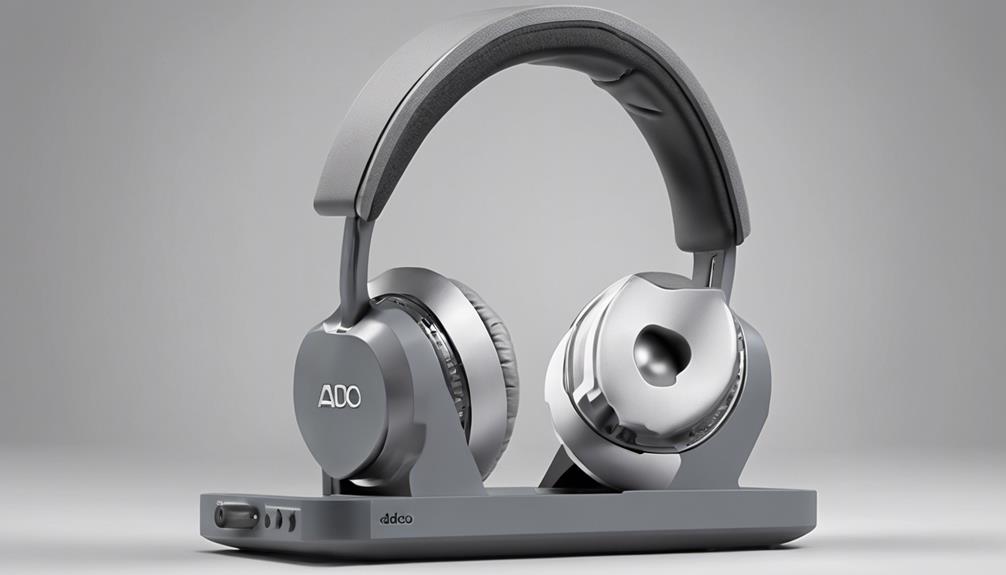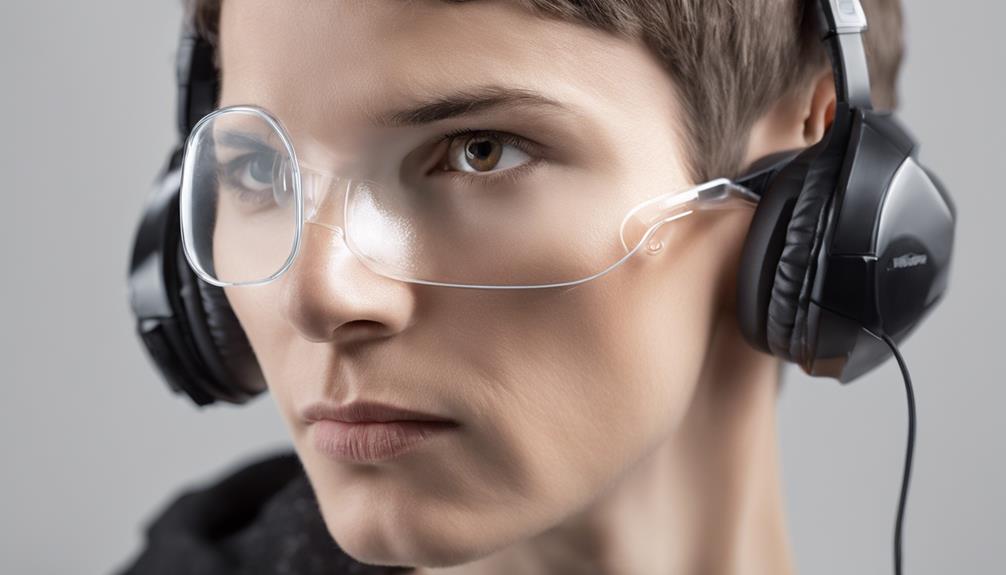Through a stroke of luck, we stumbled upon a plethora of state-of-the-art solutions in the realm of assistive listening devices equipped with FM technology, all geared towards enhancing sound quality for those with hearing impairments.
From compact microphones to robust transmitters and receivers, these devices offer a glimpse into the transformative power of technology in the realm of accessibility.
With a focus on clarity and effectiveness, these devices hold the potential to revolutionize how individuals engage with their surroundings.
Key Takeaways
- FM systems provide clear sound transmission for improved listening experiences.
- They enhance speech intelligibility and reduce background noise.
- FM systems are beneficial in various settings like classrooms, theaters, and restaurants.
- Prices for FM systems vary based on features and technology, ranging from $150 to several thousand dollars.
FM Systems Overview
When using FM systems, clarity and enhanced sound quality are achieved through the transmission of audio via FM radio signals. FM systems are designed to assist individuals with hearing impairments by transmitting sound signals directly to hearing aids or cochlear implants. These systems typically consist of a microphone to capture the sound, a transmitter to convert it into FM radio signals, and a receiver that picks up these signals for the user.
In various settings such as classrooms, theaters, and churches, FM systems play a crucial role in ensuring that individuals with hearing difficulties can access clear and amplified sound. By wearing a microphone or placing it near the sound source, users can benefit from the direct transmission of audio to their hearing devices, bypassing background noise and enhancing the overall listening experience.
Benefits of FM Systems

FM systems offer a range of benefits for individuals with hearing impairments. These include improved sound clarity and an enhanced listening experience. By transmitting sound directly to hearing aids or receivers, these systems ensure that users can better discern speech and other audio cues.
Whether in educational environments or public spaces, FM systems play a crucial role in facilitating effective communication for those with auditory challenges.
Improved Sound Clarity
Utilizing FM systems enhances the sound clarity experienced by individuals with hearing impairments or auditory challenges. These systems work by transmitting amplified sounds directly to hearing aids, ensuring improved reception and understanding of speech.
The benefits of FM systems for sound clarity include:
- Reduced background noise: By transmitting the speaker's voice directly to the listener's hearing aids, FM systems help minimize distracting background noises.
- Enhanced speech intelligibility: The clear transmission of sound through FM systems makes speech easier to understand, particularly in noisy environments.
- Improved listening comfort: Users experience less strain and fatigue when listening with FM systems due to the enhanced sound quality, contributing to a more enjoyable listening experience overall.
Enhanced Listening Experience
Enhancing the auditory experience for individuals, FM systems deliver clear and direct sound transmission to hearing aids or receivers, ensuring optimal speech understanding and improved communication in various settings. By reducing background noise and minimizing signal distortion, FM systems significantly enhance speech comprehension for users. This results in improved listening comfort and overall better understanding, especially in noisy environments such as classrooms, theaters, and workplaces.
The technology integrated into FM systems guarantees top-notch sound quality and speech intelligibility, making them indispensable tools for individuals seeking enhanced listening experiences. With FM systems, users can enjoy clear, crisp sound directly delivered to their hearing aids, creating a more immersive and effective communication experience in challenging acoustic environments.
Considerations for FM Systems
When considering FM systems, it's crucial to understand their benefits, setup requirements, and maintenance protocols.
These systems offer improved sound quality and accessibility for individuals with hearing impairments.
Proper installation and regular upkeep are essential for ensuring optimal performance and longevity of FM systems.
FM System Benefits
FM systems offer a significant advantage in enhancing sound clarity. They achieve this by directly transmitting amplified sounds to hearing aids or receivers through a microphone worn by the speaker and a transmitter broadcasting signals to the receiver. When considering the benefits of FM systems, we must acknowledge their ability to reduce background noise, increase speech intelligibility, and provide a better listening experience for individuals with hearing impairments.
This technology is commonly utilized in educational settings, theaters, restaurants, and places of worship, highlighting its versatility and effectiveness in various environments. Users can expect improved communication and enhanced auditory processing. This makes FM systems an invaluable tool for those seeking clearer sound and enhanced listening experiences.
FM System Setup
Considering optimal functionality, selecting the appropriate frequency range is crucial when setting up an FM system for clear and interference-free sound transmission. The right frequency range minimizes potential disruptions and ensures a stable connection between the transmitter and receiver.
Proper microphone placement is another essential aspect of FM system setup. Placing the microphone close to the sound source enhances signal reception, leading to improved sound quality.
Additionally, users can fine-tune their listening experience by adjusting volume levels on FM systems. This feature allows individuals to personalize the sound amplification according to their specific preferences.
FM System Maintenance
To ensure optimal performance and longevity of FM systems, regular maintenance checks on batteries, connections, and microphone functionality are essential considerations. Cleaning the microphone, transmitter, and receiver regularly is crucial to prevent audio distortion or signal interference. Proper storage of FM system components in a dry and safe environment can significantly extend their lifespan and functionality.
Additionally, conducting periodic system checks and testing in various environments helps identify any issues or adjustments needed for FM systems.
- Regular maintenance checks on batteries, connections, and microphone functionality are crucial.
- Cleaning the microphone, transmitter, and receiver regularly prevents audio distortion.
- Proper storage in a dry and safe environment can extend the lifespan of FM system components.
How FM Systems Work

Using a sophisticated microphone, the FM system transmits sound directly to a specialized receiver, significantly enhancing audio clarity and volume for individuals facing hearing difficulties. The microphone captures the speaker's voice or sound source and broadcasts it via FM signals to the receiver, which can be worn or placed near the listener. This technology is commonly utilized in environments like classrooms and theaters where background noise or distance from the speaker may impede clear hearing. FM systems play a vital role in assistive listening devices, establishing a direct audio link between the speaker and listener for improved communication.
| FM Systems | Receiver | Transmit Sound |
|---|---|---|
| Microphone captures sound | Specialized device | Enhances clarity |
| Uses FM signals | Worn or placed near listener | Improves volume |
| Common in classrooms/theaters | Reduces interference | Vital for communication |
Ideal Settings for FM Systems

When considering the ideal settings for FM systems, it's crucial to understand the benefits they offer, the range coverage they provide, and the set-up process involved.
FM systems can significantly enhance sound clarity in various environments, making them particularly useful in classrooms, theaters, and auditoriums.
Properly configuring the FM system ensures optimal signal transmission and reception, improving the overall listening experience for individuals with hearing difficulties.
FM System Benefits
In educational environments such as classrooms, auditoriums, and lecture halls, FM systems play a crucial role in enhancing sound clarity and speech comprehension for individuals with hearing loss and auditory processing disorders. These systems transmit sound directly to hearing aids, reducing background noise and improving listening experiences. Ideal settings for FM systems include noisy environments like restaurants, theaters, and churches where clear sound reception is essential.
- FM systems enhance speech intelligibility, aiding individuals with auditory challenges.
- They facilitate better focus and attention, particularly in noisy or crowded spaces.
- FM systems are integral tools in educational settings, improving academic performance for students with hearing impairments.
FM Range Coverage
Achieving optimal sound clarity and transmission range within ideal settings is essential for maximizing the effectiveness of FM systems in various environments. FM systems typically offer a range coverage of up to 150 feet under optimal conditions. Within this range, clear sound transmission is maintained, making FM systems suitable for spaces like classrooms, theaters, and small to medium-sized rooms.
However, factors such as interference, obstacles, and signal strength can influence the actual range coverage. Users can expect consistent sound quality when positioned within the specified range of the FM system. Proper placement of the transmitter and receiver is critical to fully exploit the system's range coverage capabilities.
To ensure reliable and clear sound transmission, adherence to ideal settings is paramount.
FM System Set-Up
To optimize the performance of FM systems, ensuring proper placement of the microphone near the speaker or sound source is crucial for maximizing signal reception. When setting up FM systems, consider the following:
- Positioning: Place the microphone close to the speaker to enhance signal reception.
- Customization: Adjust volume levels and frequency channels to personalize the listening experience.
- Interference Reduction: Maintain a clear line of sight between the transmitter and receiver to minimize interference in FM system set-ups.
These steps are essential for achieving optimal performance and clear sound transmission in environments such as classrooms, theaters, lecture halls, and large meeting rooms where FM systems are commonly used.
Cost of FM Systems

Considering the wide range of prices spanning from $150 to several thousand dollars, the cost of FM systems varies based on multiple factors such as model specifications and included features. Prices can fluctuate depending on the manufacturer, technology utilized, and additional components provided. Factors like the type of microphone, receiver, and necessary accessories for specific settings can also impact the overall cost. Some FM systems are available in kits that encompass all essential components for convenient setup, potentially affecting the total expenses. Consulting with a hearing care professional or audiologist can aid in determining the most suitable FM system within a specified budget range.
| Factors Affecting Cost | Description |
|---|---|
| Manufacturer | Influences pricing |
| Technology Used | Impacts overall cost |
| Additional Components | Can increase expenses |
| Microphone Type | Affects pricing |
| Kit Inclusion | May impact total cost |
ADCO Hearing Products FM System

After exploring the varying costs associated with FM systems, let's now examine the advanced features of the ADCO Hearing Products FM System.
ADCO Hearing Products offers an FM system designed to provide clear sound transmission for individuals facing hearing challenges in diverse environments. Here are some key points about the ADCO FM system:
- The FM system from ADCO Hearing Products prioritizes clear sound transmission, ensuring that users experience enhanced audio quality and improved speech comprehension.
- ADCO's FM system includes a variety of compatible accessories that contribute to an optimal user experience, allowing individuals to customize their listening preferences for different settings.
- Users can benefit from the advanced technology incorporated into ADCO's FM system, which emphasizes accessibility and quality to deliver an exceptional listening experience.
Williams Sound FM ADA Kit

The Williams Sound FM ADA Kit, designed for meeting ADA compliance requirements for hearing accessibility, offers a comprehensive solution for accommodating individuals in small group settings effectively. This kit includes all the necessary components to ensure clear sound transmission in environments where ADA compliance is essential.
Priced at $1,950.00, the FM ADA Kit remains a cost-effective option for organizations seeking to provide hearing assistance without compromising quality. Tailored specifically for use in small spaces and with small groups, this kit is optimized for practicality and functionality.
Williams Sound PFM PRO RCH System

In small group settings requiring superior audio transmission for enhanced accessibility, the Williams Sound PFM PRO RCH System offers a rechargeable FM listening solution designed to deliver clear and amplified sound directly to the ear. This FM listening system is ideal for personal use and provides the following benefits:
- Portable and convenient design for on-the-go assistive listening needs.
- Enhanced sound quality in various settings, catering to individuals who require clear and amplified sound.
- Reliable choice for high-quality sound transmission in personal and professional environments.
The Williams Sound PFM PRO RCH System stands out for its versatility and reliability, making it a valuable tool for individuals seeking top-notch audio performance. With its rechargeable feature and superior sound delivery, this system ensures an optimal listening experience for users in need of clear sound amplification.
Williams Sound FM 558 Large Area System

Utilizing WaveCAST Wi-Fi audio server technology, the Williams Sound FM 558 Large Area System delivers professional-grade wireless listening experiences for enhanced sound distribution in diverse venues.
This assistive listening device offers end users the convenience of wireless listening, making it suitable for various settings. Priced at $1,975.00, the system provides value for those seeking effective sound distribution in large areas.
Specifically designed for venues like theaters, auditoriums, and lecture halls, the Williams Sound FM 558 system prioritizes sound clarity and quality. Users can trust this system for reliable and efficient large area sound transmission, ensuring an optimal listening experience for all.
With its integration of advanced technology and focus on professional sound delivery, the Williams Sound FM 558 Large Area System stands out as a top choice in the realm of FM systems for clear sound distribution.
Frequently Asked Questions
What Is an FM Assistive Listening Device?
An FM assistive listening device comprises a microphone, transmitter, and receiver that transmit amplified sounds directly to hearing aids.
It's commonly used in various settings like classrooms, restaurants, theaters, and churches to enhance sound clarity for individuals with hearing challenges.
The microphone captures sound from the speaker or sound source, transmitting the signal via the transmitter to the receiver for direct reception.
This setup provides a clear and direct audio connection to hearing aids, improving accessibility in different listening environments.
Can You Use FM System Without Hearing Aid?
Yes, we can use FM systems without hearing aids. It's like having a direct line to crystal-clear sound.
FM systems transmit audio straight to receivers, making speech easier to understand for those without hearing aids. These systems benefit people with mild hearing loss, auditory processing issues, or in noisy settings.
Even individuals facing temporary hearing challenges or non-native speakers can improve communication with FM systems, enhancing their overall listening experience.
What Are the Four Major Types of Assistive Listening Devices?
Certainly!
The four major types of assistive listening devices are:
- FM systems
- Personal amplifiers
- Infrared systems
- Hearing loops
Each type serves a unique purpose in improving sound reception for individuals with hearing impairments.
FM systems transmit amplified sounds directly to hearing aids, personal amplifiers enhance sound quality for various activities, infrared systems offer signal privacy in public spaces, and hearing loops minimize background noise for clearer sound in specific settings.
What Is the Best Device for Auditory Processing Disorder?
We believe the best device for auditory processing disorder is a personal FM system.
Like a beacon guiding a ship through turbulent waters, FM systems transmit clear sound directly to our hearing aids or receivers. These systems excel at reducing background noise and enhancing speech clarity, crucial for individuals facing auditory processing challenges.
Conclusion
In conclusion, these 10 assistive listening devices with FM systems are truly game-changers for individuals with hearing challenges.
With crystal clear sound transmission, easy accessibility, and versatile applications, these devices revolutionize the way individuals with hearing impairments engage with their surroundings.
Say goodbye to muffled or distorted sounds, and hello to a world of enhanced communication and enjoyment.
Upgrade your listening experience today with these top-of-the-line FM systems!











